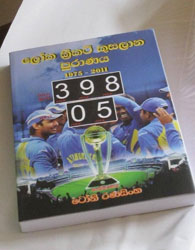“All we can do is simply to give our best. There is no holding back, we have to fight every step of the way to try and re-live the amazing sense of victory that comes with winning a World Cup,” writes Sri Lanka captain Kumar Sangakkara in Tony Ranasinghe’s book ‘Loka cricket kusalana puranaya’ that details the history of World Cup cricket over the years.
Answering the question “Can we win it?” he says: “Well, I think we are standing on the threshold of something very special. I truly believe we have a special opportunity this year. We are a very proud outfit that is both close-knit and hard-working. We are fortunate to still have a couple of legends, especially Murali and Mahela, but we are also blessed to have some brave youngsters with great attitudes.”
Kumar also talks about what it means to be playing in front of thousands of your own proud fans. “It is always uplifting and inspiring,” he says. “Some people claim that playing at home adds to the pressure, but I would always prefer to be cheered on by passionate Sri Lankan supporters.”
 |
Tony, a star-turned writer, has been fortunate enough to get most of the Sri Lankan captains to respond to his request to contribute their thoughts on the World Cup. Anura Tennekoon who led our team to the inaugural World Cup in 1975, says it was a useful exercise although we did not fare too well. He recalls how opener Sidath Wettimuny and star batsman Duleep Mendis were dispatched to hospital by pace bowler Jeff Thompson where they had to spend a night.
The team didn’t have a proper place to stay. They were put up at the Students’ Centre in London. The Board of Control did not have funds to put them up in a decent hotel. In fact, D.S. de Silva who was a team member remembers sleeping on the floor of the Sri Lanka High Commissioner’s residence.
Sri Lanka hardly had any experience in one-day cricket at the time, nor were there proper training facilities. Anura remembers the team going up to Nuwara Eliya for a ten-day training camp to get acclimatised to the English weather. There were no physios and coaches to accompany the team. Neither did they have proper cricket gear. It was the determination of the Board President Robert Senanayake that made it possible for the team to go for the World Cup.
Looking back, those were the days when only Ceylon Tobacco Company helped sports in the country. It was virtually impossible to find a sponsor for any sport. When the Board approached Ceylon Tobacco for funds to get air tickets for the team to go for the World Cup, the company readily agreed. That was the time Anura was working in the Company – so it was prestigious for the Company to see a company staffer captaining the national team to the prestigious event.
Even when Duleep Mendis captained the 1983 team to the World Cup, Sri Lanka did not have the luxury of taking along a physio. He remembers the assistant manager doubling up as the physio! He also recollects that our fielding was weak.
Tony who dedicates the book to cheer leader Percy Abeysekera, has collected vital data as well as interesting bits and pieces for his introductory essays on each World Cup tournament. He mentions several ‘firsts’ at the 1992 Benson & Hedges World Cup held in Australia and New Zealand. It was the first time a day night match was played. A red ball was used in place of the white ball. The sight screens were black (earlier they were white). The players wore coloured clothing. A camera eye was fixed to the wicket for television replays. Of the 25 games played, 10 were day night games. The group photograph of the teams was taken on a ship anchored in Sydney harbour.
Tony is sorry that he was not able to get at Arjuna Ranatunga to do a piece about the 1996 victory.
Tony has reproduced scores of all the matches played in the nine tournaments from 1975 – 2007. He also gives lists of players who had the highest scores, those who took the most number of wickets, best wicket-keepers, players who took the largest number of catches and performances of captains. A list of umpires with the matches they have umpired completes the records- all very interesting and valuable information.
The near 400-page Godage publication is a superb reference book for any cricket fan, particularly those who revel in statistics. |


